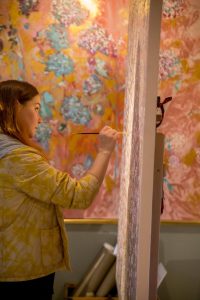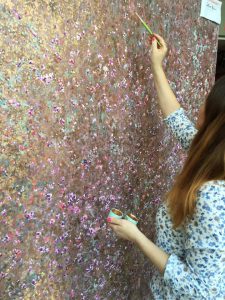
Pressetext
Deutsch
Zu ihren Fans zählen inzwischen Menschen aus aller Welt, ihre Bilder hängen weltweit nicht in Galerien, sondern in den Wohnungen und Häusern von Liebhabern des Schönen. Wer einmal eines ihre großformatigen Bilder besitzt gibt es meist nicht mehr her. Bei Anfragen von Galerien gibt es meist eine höfliche und zum Teil auch ein wenig verzweifelte Absage. Ihre Warteliste ist lang und wächst, Bilder, die in ihrer Werkstattgalerie nahe der Hamburger Elbphilharmonie entstehen, werden häufig noch während des Entstehens verkauft.

Wie bei nahezu jedem Künstler war der Weg zum Erfolg steinig. Die gebürtige Tatarin aus Kazan wurde zwar schon klein auf gefördert, ihr Vater – ebenfalls Künstler – verstarb aber schon früh und trotzdem bestimmte die Kunst immer ihr Leben. Von der Kunstschule zur Kunstakademie bis hin zur berühmten Stiglitz-Akademie in St.Petersburg, immer versuchte sie ehrgeizig ihre Ziele umzusetzen. Als sie 1999 nach Deutschland kam, glich es einem Neuanfang, keine Netzwerke, keine Galeristen und die Konkurrenz von ehrgeizigen männlichen Kollegen machten es der damals alleinerziehenden Mutter nicht einfach sich durchzuschlagen. Und dennoch schaffte sie es immer mit der Kunst ihren Lebensunterhalt zu verdienen. Bei den Galeristen hatte sie wegen ihre großformatigen Werke immer einen schweren Stand, niemand wollte der damals unbekannten Künstlerin Platz an den Wänden einräumen und so machte sie sich selbst an die Vermarktung, organisierte Veranstaltungen in ihrem Atelier in der Speicherstadt um Menschen mit ihren Werken vertraut zu machen. Schon damals fand sich ein kleiner, eingeschworener Kreis von Fans, deren Wohnungen noch heute die frühen Werke Lilia Nours zieren.

Der große Durchbruch kam dann nicht durch eine Entdeckung durch einen Galeristen oder Kurator, sondern geschah durch einen glücklichen Zufall: Als 2015 eine Ladenwohnung in unmittelbarer Nähe zur Elbphilharmonie frei wurde, sagte sie kurzentschlossen der Speicherstadt Ade, den ungeheizten Böden dort hat ihre Gesundheit Tribut genug gezollt. Endlich wurden ihre Werke für eine breite Öffentlichkeit erlebbar und der Erfolg stellte sich unmittelbar ein. Faktisch vom ersten Tag an wurden ihre Bilder verkauft und mit der Eröffnung der Elbphilharmonie wurde es schwierig für sie und ihre Fans. Einige Serien ihrer Bilder werden so schnell verkauft, das nur Schnellentschlossene eine Chance auf ein Bild haben. Trotz der Wartelisten versucht sie sich ihre Spontanität zu bewahren und malt worauf sie gerade Lust hat. Und so kann es eben doch passieren, das Passanten zum Zuge kommen – weil sie nicht nach Liste malen will, und weil ein gerade im Werden befindliches Bild sich genau in dem Moment offenbart, an dem der Betrachter sie in ihrem offenen Atelier beobachtet.

Alle ihrer Werklinien zeichnen sich dadurch aus, dass sie mit großzügigem Farbauftrag gearbeitet werden. Seien es die eher monochromatischen Motive ihrer Fiskultura-Serie, ihre häufig mit Gold gearbeiteten konstruktivistischen Hafenmotive oder ihre üppige florale Zen-Malerei. Nie wird auf die blanke Leinwand gearbeitet, die vielschichtige Grundierung ist integraler Bestandteil aller Werke – und die spätere Wirkung im Raum. Immer achtet sie darauf, dass keine großartige Beleuchtung notwendig ist um ihre Werke in normalen Wohnungen zur Geltung zu bringen. Häufig findet man unauffällige Einsprengsel von Gold in ihren Bildern, die Farbschichten werden in vielen Ebenen mit einem kleinen Spachtel aufgetragen und erzeugen beim Betrachter immer andere Eindrücke je nach Standpunkt und Lichteinfall. Die aufwendige Arbeitsweise fordert ihren Tribut. Bis zur Fertigstellung eines ihrer Bilder vergehen oft Wochen, eine natürliche Grenze für ihren Jahresoutput.
Abdruck erlaubt
English
Her fans are people from all corners of the world, her paintings are worldwide enjoying lovers of beautiful things in their homes and are not intended to stay only in the galleries and exhibitions around the world. Once you are a owner of one of her big sized paintings, you mostly don’t want to miss it nor sell it. If galleries ask for paintings, most of the time they receive a polite and slightly desperate answer: I don’t have any paintings for an exhibition. Her queue is long and growing, paintings that she starts are often already sold while they are created by Lilia.
As nearly every artist in the world the way to success was stony. Born in Kazan – she is a Tatar – in the former Soviet Union, now capital of Tatarstan, her talent was early discovered and supported, first by her father, a painter as well and then by public art schools. She finally study art and restauration at the famous Stieglitz academy in St.Petersburg. Se never did a step beside art, where other artist starts earning money with jobs in other businesses, she stays true with herself, earns money with street painting and restauration. When she 1999 finally moves to Germany it was a hard cut: No networks, no supporting gallery and the competitions with a lot of ambitious male colleagues made life not easy for the single parent mother. The gallery owners were not willing to offer space for her already big sized paintings, so she was on her own to sell her art. Her tatar blood always let her be a bit risky, she rented a studio and starts organizing events to sell her art on her own in the famous Hamburg Speicherstadt, a warehouse district with cheap space and today world cultural heritage. A small circle of fans supported her and still that circle is the foundation of her success. The breakthrough happens when she moved her studio into the public near to the newly opened Elbphilharmony. Thousands of people saw her working inside a former shop, on display for everyone, not only for art addicts. Immediate a lot of people fell in love with her works, from the first day she starts selling her paintings, on some series of her art a competition of the buyers starts who will get the next. Very fast she sold all of her stocks from the less successful days of her working and today she is most of the time working on commissions – not all the time to keep her creativity alive and to offer still surprise for other people.
All her series have in common, that she always applies paint very generous and complex. Never she starts a new work on a simply finished canvas, she spends a lot of time in creating a multi-level background. She says that modern printing tries to trick the human eyes, but subconscious people see the difference of having several layers of paint – especially with oil paint – and the single layer of a print. From the monochromatic works of her Fiskultura series, the fantastic harbour cranes to the lush and life loving floral paintings of her Sakura series, no painting needs artificial lights and are always builds the centre of the living space where they are located. Especially the works of the Sakura series are extremely intense in creation. Usually, it takes around two months to create on of these paintings. Level by level the paint is applied to the canvas, with a small spatula every leaf of one of the hundreds of blossoms is applied, the structures raising from the plain level of the canvas, gold leaves in addition leads to a result that looks always different from every angle of viewing and direction of light. This intense working style of course limits her output of a year, not more than 10-15 works leaves her studio.